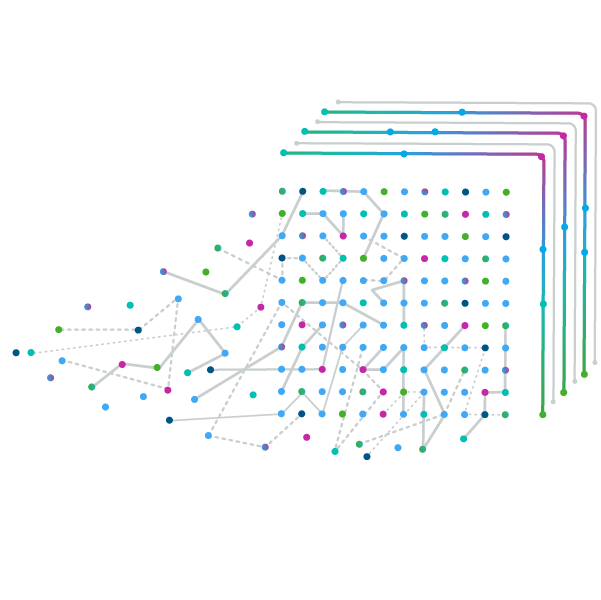Accelerate the development of new therapies.
Growing demand for EHR data reveals fundamental limitations
Widespread adoption and interoperability of EHRs have been key US policy priorities since 2009 (Henry et al., 2016), and billions of dollars have been spent by providers and the federal government towards achieving these aims (Glaser, 2020).
In some ways, these efforts have been a success. The secondary use of EHR clinical data outside of direct care delivery has increased in demand, due to its utility in quality measurement, public health, research, and enriching the understanding of the effectiveness and efficiency of health care systems. However, this growing demand for EHR data has also revealed fundamental limitations in downstream usability, such as benchmarking clinical quality, understanding patient populations, and conducting research studies.
The problem: EHR data is generated by providers, however input of data can vary significantly between EHR systems, and even between individual providers in the same department. Therefore, even though EHR data may contain highly valuable and detailed clinical data, the data may be nearly impossible to access without significant time and effort.
Much of this lack of usable and interoperable data can be attributed to limitations and slow adoption of agreed upon common data elements and current standards for structured collection of disease- and specialty-specific variables. Where there is either a lack of options for structured data entry, or a lack of consensus and commitment to capturing information in a particular way, physicians are likely to document much of the clinical information in free text rather than discrete data fields. Thus, the information captured will be highly variable and difficult to access and leverage by users beyond that particular physician or practice. This creates many issues for care coordination as there is little immediate impetus for documenting patient data in a particular way if it will not be used to follow an established treatment pathway.
It is possible to convert unstructured data to a structured format for use in both clinical care and downstream research through methods such as chart reviews or natural language processing (NLP), however, both chart reviews and NLP algorithm development can be costly, time-intensive processes. To achieve true, sustainable health data interoperability, it is necessary to standardize and structure clinical data at the point of collection.
Medical specialty societies are ideally positioned to drive the development and adoption of new data standards for their specialty areas
Medical specialty societies are often the best candidates to lead specialty-centric data standardization efforts because of their access to deep clinical expertise, physician-centricity, and strong convening power across institutions and geographies. Additionally, as experts in their specialty areas, medical specialty societies are in an ideal position to coordinate the thoughtful addition of new clinical content standards needed for physicians in their specialty, and to ensure these standards are developed with “formal, explicit, reproducible methods for recognizing and filling gaps in content” (Cinimo, 1998). Finally, Medical specialty societies can use their clinical knowledge and broad stakeholder relationships to develop custom messaging needed to bring everyone together in support of this common goal.
Medical specialty societies also stand to benefit significantly from the downstream use cases that are enabled when clinical data is captured in a more structured and consistent format. These benefits can include:
- Capture of novel quality measures through a more granular view of patient pathway
- Decreased burden on physicians to input data intro registry and registry coordinators in cleaning and structuring information
- Broader data capture from existing EHR inputs, enabling broader data and registry use cases. For example:
- Ability to benchmark clinical outcomes by provider, care site, and treatment pathway
- Identifying new clinical endpoints for treatment guidelines and regulatory use
- Improve the ability to support value-based contracting agreements through ability to access structured clinical outcomes data
Stay tuned for strategies you can use to overcome key challenges
Driving clinical documentation standardization is a complicated and resource-intensive process. However, it is also critical for the advancement of research and patient care. In an upcoming whitepaper, we’ll take a closer look at the challenges inherent in advancing data content standards and present some strategies successful organizations have employed along the way.
Sources
Cimino J. J. (1998). Desiderata for controlled medical vocabularies in the twenty-first century. Methods of information in medicine, 37(4-5), 394–403.
Glaser J. It’s Time for a New Kind of Electronic Health Record. Harvard Business Review. Published online June 12, 2020. Accessed April 11, 2022. https://hbr.org/2020/06/its-time-for-a-new-kind-of-electronic-health-record
Henry J, Pylypchuk Y, Searcy T, Patel V. Adoption of Electronic Health Record Systems among U.S. Non-Federal Acute Care Hospitals: 2008-2015. :11.
Related solutions
See how we partner with organizations across the healthcare ecosystem, from emerging biotechnology and large pharmaceutical, to medical technology, consumer health, and more, to drive human health forward.

























